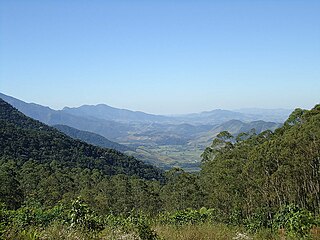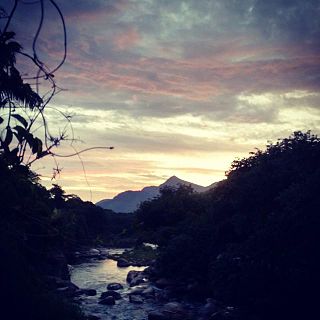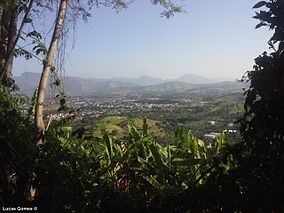History
The Gericino / Mendanha Massif was declared an Atlantic Forest Biosphere Reserve by UNESCO in 1992. Before the park was created the area was protected by an environmental protection area, a less strict form of protection than a state park. At the time of creation the state environmental secretary Carlos Minc said the massif had been suffering from clandestine mining, illegal extraction of natural resources, and uncontrolled leisure and tourism activities.
The Mendanha State Park was created by state decree 44.342 of 22 August 2013. The objectives are to protect and assist the recovery of the natural environment and landscapes of great scenic beauty, a densely forested area that shelters rare and endangered species, as well as to protect the water resources of the region. The park is part of the Carioca Mosaic, established in 2011. An environmental police unit was to be established to patrol the park by 2014.
The federal government filed an action in 2015 against the state of Rio de Janeiro to suspend creation of the park on the grounds that much of it is on federal land that was being used as the army's Gericinó Training Area. The firing range is dangerous due to live explosive devices. The army had not been consulted in the meetings before creation of the park, and the state seemed to have ignored the fact that much of the land was federal property.

The Tijuca National Park is an urban national park in the mountains of the city of Rio de Janeiro, Brazil. The park is part of the Atlantic Forest Biosphere Preserve, and is administered by the Chico Mendes Institute for Biodiversity Conservation (ICMBio).

Resende is a municipality in the Brazilian state of Rio de Janeiro. The population is 132,312 in an area of 1094 km². Resendense refers to people or things that come from or inhabit Resende. It is the oldest town in this region, which has boundaries with the state of São Paulo and Minas Gerais. It is an important industrial, automotive, metallurgical, and tourist center, and headquarters of the world's second-largest military complex, the Academia Militar das Agulhas Negras (AMAN). Resende is of national importance and houses the Nuclear Fuel Factory complex of the "Indústrias Nucleares" of Brasil, the only one able to enrich uranium. Resende's automotive area holds MAN Latin America, the biggest truck and bus factory of Brazil, limited to PSA Peugeot Citroën and Michelin.

The Ilhas Cagarras are an uninhabited archipelago located 5 km off Ipanema, a major beach of the southern coast of the city of Rio de Janeiro, Brazil. They have been designated a federal natural monument since 2010.

Tamoios Ecological Station is a coastal marine ecological station in the state of Rio de Janeiro, Brazil.

Praia do Sul State Biological Reserve is a biological reserve on the island of Ilha Grande, in the State of Rio de Janeiro, in Brazil.

Guaratiba Biological and Archeological Reserve is a State biological reserve located in the western zone of Rio de Janeiro city, in the State of Rio de Janeiro, Brazil. It protects an important area of mangroves and wetlands in the east of Guaratiba Bay.

The Marapendi Natural Municipal Park is a municipal nature park, a public recreation facility of approximately 155 hectares within the Marapendi Natural Reserve, located in the Barra da Tijuca and Recreio neighborhoods of Rio de Janeiro, Brazil and part of a protected area for the preservation of native plants and animals.

A protected area mosaic or conservation unit mosaic in Brazil is a mosaic of nearby, adjoining or overlapping protected areas of Brazil that are managed as a whole.

The Ilha Grande State Park is a state park in the state of Rio de Janeiro, Brazil.

The Mantiqueira Mosaic is a protected area mosaic that contains conservation units in the states of Rio de Janeiro, São Paulo and Minas Gerais, Brazil. The conservation units are of different types and are managed at the federal, state or municipal level. The mosaic provides a level of integrated and coordinated management.

The Pedra Selada State Park is a state park in the state of Rio de Janeiro, Brazil.

The Três Picos State Park is a state park in the state of Rio de Janeiro, Brazil. It preserves a large, mountainous region of Atlantic Forest.

The Paraíso Ecological Station was an ecological station in the state of Rio de Janeiro, Brazil. In 2013, it was absorbed into the Três Picos State Park.

The Floresta do Jacarandá Environmental Protection Area was an environmental protection area in the state of Rio de Janeiro, Brazil.

The Bacia dos Frades Environmental Protection Area is an environmental protection area in the state of Rio de Janeiro, Brazil.

The Bacia do Rio Macacu Environmental Protection Area is an environmental protection area in the state of Rio de Janeiro, Brazil.

The Macaé de Cima Environmental Protection Area is a state-level environmental protection area in the state of Rio de Janeiro, Brazil. It protects an area of Atlantic Forest in the Serra do Mar mountains.

The Desengano State Park is a state park in the state of Rio de Janeiro, Brazil. It protects an area of rugged mountains with a large remnant of Atlantic Forest that is home to various endangered species.

The Carioca Mosaic is a protected area mosaic in the state of Rio de Janeiro, Brazil. It includes various federal, state and municipal conservation units in and around the city of Rio de Janeiro.

The Sugarloaf Mountain and Urca Hill Natural Monument is a natural monument in the city of Rio de Janeiro, Brazil. It protects the Sugarloaf Mountain and the adjoining Morro da Urca, distinctive landmarks of the city.
This page is based on this
Wikipedia article Text is available under the
CC BY-SA 4.0 license; additional terms may apply.
Images, videos and audio are available under their respective licenses.

















